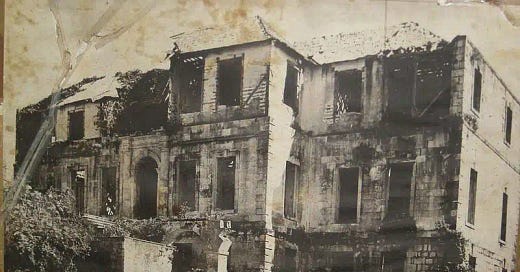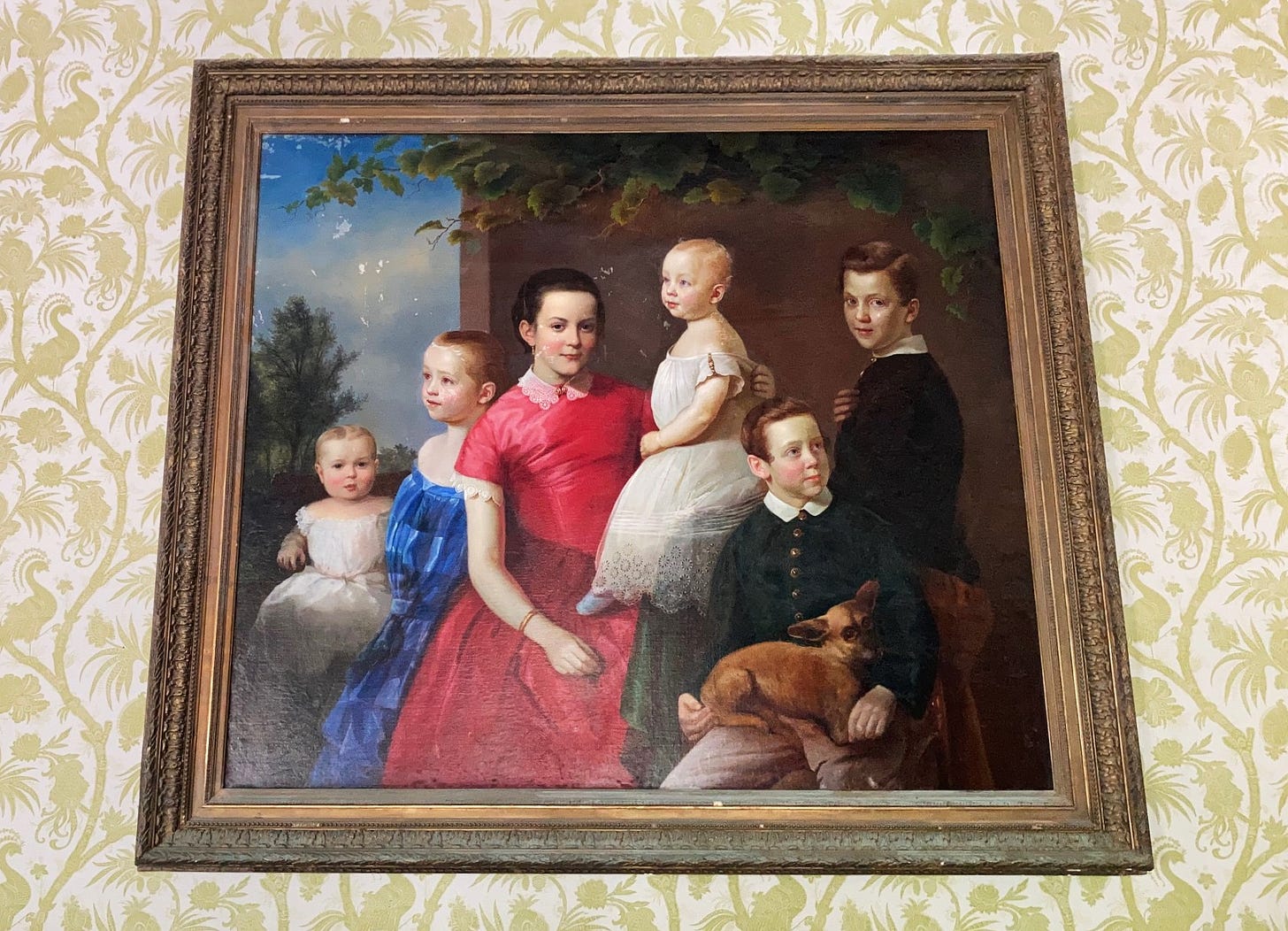
A woman attired in flowy, faux-slave garb stood in front of a tomb. While staring gravely into the far distance, she intoned:
On the Island of Jamaica quite a long long time ago
At Rose Hall Plantation where the ocean breezes blow
Lived a girl named Annie Palmer the mistress of the place
And the slaves all lived in fear to see a frown on Annie's face
Where's your husband Annie, where's number two and three
Are they sleeping beneath the palms beside the Caribbean Sea
At night I hear you ridin' and I hear your lovers call
And still can feel your presence round the great house at Rose Hall (and on, and on)
My guide’s rendition of a song Johnny Cash wrote about a fictionalized Annie Palmer, was the most awkward few minutes of what had been a thoroughly uncomfortable tour of the Rose Hall Great House near Montego Bay, Jamaica.
I’d ended up at this place one hot afternoon in June of 2021 after asking a Half Moon concierge where I could tour a historically accurate plantation.
“I know there’s a tourist trap near here, but I don’t want to go to that one,” I said. My decision to leave the resort was spur-of-the-moment and my brain powers had been dulled by the heat, so I couldn’t recall the name of the allegedly haunted “tourist attraction” Great House I’d read about.
Guess where I ended up?
If you’ve flown into Montego Bay’s Sangster International Airport, you’ve likely seen advertisements for Rose Hall Great House and the White Witch thereof. If you’ve Googled “Top 10 Things to Do in Montego Bay,” you’ve definitely encountered said Great House and its alleged White Witch.
If you have any respect for historical accuracy, stay as far away as possible from this lair of untruths.
Here’s the myth—the highly profitable myth—of the White Witch of Rose Hall, as summarized by me:
Annie Palmer was a white woman who came to Jamaica by way of Haiti, where her black nurse indoctrinated young Annie into voodoo. After marrying and moving to Rose Hall Plantation, Annie brutally murdered her three husbands, several of her slave lovers, perhaps her baby, and heaven only knows who else. Annie, in turn, was brutally murdered by one of her many slave lovers, slaves who she abused by day and had passionate trysts with by night.
Johnny Cash may have claimed to still feel Annie’s presence at the Rose Hall Great House; however, he had ulterior motives (money, friendship with the wealthy, white Delaware family that purchased and renovated the house in the 1960s, and, oh yeah, that sold Johnny the adjacent Cinnamon Hill Great House).
I completely failed to feel the presence of Annie Palmer, either in her real or mythologized forms.
Nor, when viewing what allegedly is a portrait of young Annie with a bunch of children whose purported identities I’ve forgotten, had I seen the evil in her eyes that the guide demanded I notice.
The only presence I felt at the end of my tour was anger at the way that Annie Paterson Palmer had been portrayed, and the way that the hundreds of enslaved people who had lived and worked on the Rose Hall sugarcane plantation had scarcely been acknowledged.
My guide’s steadfast refusal to answer my questions regarding the veracity of specific things she said was impressive. According to her highly scripted telling, Rose Hall’s enslaved people were mere pawns of the wicked Annie, a petite, 20-something widow who singlehandedly beat, sexually abused, and/or murdered them.
As I stomped away from Annie’s alleged tomb (news flash: her remains are actually buried in a Montego Bay cemetery), I thought something along the lines of “Someone needs to set the record straight because this nonsense is an insult to the people who were enslaved here and to the real Annie Palmer.”
And, guess what? Someone did!
In her 2022 book Unsilencing Slavery: Telling Truths About Rose Hall Plantation, Jamaica and its companion website, author Celia Naylor methodically resurrects from archival records the names and extant information about the lives of the 208 people enslaved at Rose Hall Plantation between 1817-1832. (Slavery was outlawed in Jamaica in 1834, leading to the subsequent decline of the country’s plantation-based sugar economy.) Reading Naylor’s book and exploring the (Un)Silencing Slavery website is an insightful and sobering look at what the scant surviving records reveal about the lives of the people enslaved at Rose Hall Plantation.
The last two chapters of Naylor’s book also provide a sobering look at how fiction has been peddled as history.
The script for the Rose Hall Great House tours is the same one that’s been used since the house was opened to the public in the early 1970s. This tour is grounded not in the archival evidence that Naylor combed for her book, but in a melodramatic work of fiction written in 1929 titled The White Witch of Rose Hall. That novel, in turn, was based on an 1868 pamphlet titled “The LEGEND of Rose Hall.” (The caps are mine in case you missed the connotation of LEGEND, i.e., not a real story.)
While I strongly advise any history-respecting person not to waste time and money on a Rose Hall Great House tour, I don’t unequivocally discourage reading The White Witch of Rose Hall.
First of all, you can download it for free.
Second, the book contains evocative descriptions of the Jamaican land and seascape. The author, Herbert George de Lisser, was a prolific Jamaican writer and newspaperman, so he knew the island whereof he lived and wrote. Just prepare yourself for a lot of cringey dialog and characterizations.
Third, there’s this deliciously insightful line on page 77 regarding one character’s perception of another’s stories of Annie Palmer:
“She was retailing lies, of course, but she believes them.”
I don’t know whether the Rose Hall Great House guides are aware of the extent to which they are retailing lies to a gullible public. According to Naylor’s book, these guides are not historians or curators, they are people trained by a private company under the jurisdiction of the Jamaican Ministry of Tourism.
I also don’t know how much the Rollins family knows or cares about the true past of the plantation that John Rollins, Sr., and his wife, Michele, purchased and the Great House they renovated. If I were a betting woman, though, I’d lay money on “not at all.”
What I do know as a result of my eye-opening Rose Hall tour and follow-up research is that anyone interested in touring sites grounded in actual history needs to do their due diligence. In the case of plantations, I recommend reading this article.
In the case of everything else, i.e., other historic sites and/or life in general: steering clear of people, places, and publications that retail lies is always a wise idea.
Bonus material for the grammar-, usage-, and hyperbole-obsessed:
Let’s parse some of the marketing blather on the Rose Hall Great House home page. This will be an entertaining exercise, I promise.
“Immerse yourself if the heritage of the island as your expert guide shares the story of this colonial ruin restored to its former majesty in the 1960’s.”
I presume the first sentence is meant to start: “Immerse yourself in the heritage.”
In no way, shape, or form will immersing one’s self in (or “if”) Rose Hall serve as immersion in the island of Jamaica’s “heritage.” Today’s Rose Hall Great House is a set designed and paid for by rich white people from Delaware for staging the White Witch of Rose Hall story that was fabricated first in an 1868 legend, then re-told in a 1929 novel.
“your expert guide:” Rose Hall guides are expert in the art of script reading and question evasion.
“Shares the story:” Well, it is a whopper of a story.
“in the 1960’s.” For the love of all that’s grammatically holy, nothing is being possessed by the 1960s here.
“Learn about the lifestyle of the European bourgeoisie in the isles of the Caribbean in the Eighteenth Century.”
Umm, I wasn’t aware that the 18th century European bourgeois lifestyle in the Caribbean generally included torture, mariticide, baby killing, mistress-on-slave orgies, and bars in basements/dungeons (yes, there is now a bar in the former Rose Hall Great House dungeon called Dungeon Bar, where you can order a “Witches Brew” cocktail. Classy, no?)
“Witches Brew:” This one should be a possessive.
“Eighteenth Century:” Proper Usage gods, come to rescue of this web site again and change this to “18th century.”
“The tale of the Annee Palmer, the famed White Witch of Rose Hall is sure to delight.”
Did you not hear me? I call both the Grammar and Proper Usage gods to have mercy on us readers! “Annee Palmer” is not a “the.” Also, I’m going to guess that the Rollins family changed the spelling of “Annie” to “Annee” since they made up everything else about her.
Annee’s tale is “sure to delight?” Well, sure, if you’re delighted by the deliberate mis-telling of history. Sure, if you’re delighted by the slandering of a rather ordinary young woman. Sure, if you’re delighted by hearing about the mental, physical, and sexual abuse of slaves. Delight away, sicko.
Beautiful tropical gardens and personalities will colour your experience with fun along the way!”
The gardens admittedly were beautiful.
Not a single step of my “experience” was colored with “fun.”
Sources:
Naylor, Celia. (Un)Silencing Slavery: Telling Truths about Rose Hall Plantation, Jamaica, University of Georgia Press (Gender and Slavery Series), 2022.
https://unsilencing-slavery.org/
Reade Rosenberg, Leah. Nationalism and the Formation of Caribbean Literature, Palgrave Macmillan New York, 2007.
De Lisser, Herbert George. The White Witch of Rosehall. https://www.fadedpage.com/showbook.php?pid=20170821
https://jamaicagreathouses.com/rosehall/legend.html
https://wiredja.com/index.php/culture-lifestyle/jamaica-annie-palmer-a-sinister-witch-or-a-commercial-concoction
https://curioushistorian.com/the-white-witch-of-rose-hall
http://www.jamaicanfamilysearch.com/Samples2/mpalmer.htm
https://www.cntraveler.com/story/an-ethical-guide-to-plantation-tours
https://rosehall.com/rose-hall/







Very well done!
This may be your best ever! Loved it.